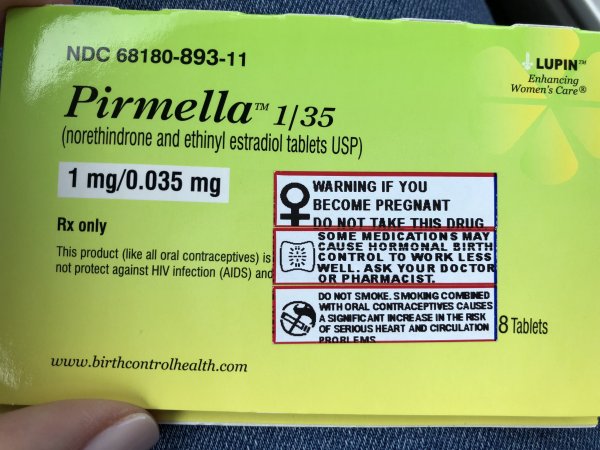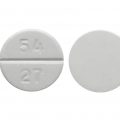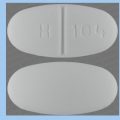Pirmella 1 35 is a brand of oral contraceptive containing the progestational compound norethindrone and the estrogenic compound ethinyl estradiol. Pirmella 1 35 works mainly by preventing the release of an egg (ovulation) during your menstrual cycle. It also makes vaginal fluid thicker to help prevent sperm from reaching an egg (fertilization) and changes the lining of the uterus (womb) to prevent attachment of a fertilized egg. If a fertilized egg does not attach to the uterus, it passes out of the body.
Besides preventing pregnancy, birth control pills may make your periods more regular, decrease blood loss and painful periods, decrease your risk of ovarian cysts, and also treat acne. Using this medication does not protect you or your partner against sexually transmitted diseases (such as HIV, gonorrhea, chlamydia).
What should I tell my doctor before taking Pirmella 1 35?
Tell your doctor if you have or ever had any of these conditions:
- abnormal vaginal bleeding
- blood vessel disease or blood clots
- breast, cervical, endometrial, ovarian, liver, or uterine cancer
- diabetes
- gallbladder disease
- having surgery
- heart disease or recent heart attack
- high blood pressure
- high cholesterol or triglycerides
- history of irregular heartbeat or heart valve problems
- kidney disease
- liver disease
- migraine headaches
- protein C deficiency
- protein S deficiency
- recently had a baby, miscarriage, or abortion
- stroke
- systemic lupus erythematosus (SLE)
- tobacco smoker
- an unusual or allergic reaction to estrogens, progestins, other medicines, foods, dyes, or preservatives
- pregnant or trying to get pregnant
- breast-feeding.
How to use Pirmella 1 35
Read the Patient Information Leaflet provided by your pharmacist before you start using this product and each time you get a refill. The leaflet contains very important information on when to take your pills and what to do if you miss a dose. If you have any questions, ask your doctor or pharmacist.
Take this medication by mouth as directed by your doctor, usually once daily. Pick a time of day that is easy for you to remember, and take your pill at the same time each day.
If you are taking the chewable tablet, you may either swallow it whole or chew it thoroughly and swallow. Carefully follow the manufacturer’s directions for your brand.
It is very important to continue taking this medication exactly as prescribed by your doctor. With certain brands of birth control pills, the amount of estrogen and progestin in each active tablet will vary at different times in the cycle. It is very important that you follow the package instructions to find the first tablet, start with the first tablet in the pack, and take them in the correct order. Do not skip any doses. Pregnancy is more likely if you miss pills, start a new pack late, or take your pill at a different time of the day than usual.
Vomiting or diarrhea can prevent your birth control pills from working well. If you have vomiting or diarrhea, you may need to use a back-up birth control method (such as condoms, spermicide). Follow the directions in the Patient Information Leaflet and check with your doctor or pharmacist for more details.
Taking this medication after your evening meal or at bedtime may help if you have stomach upset or nausea with the medication. You may choose to take this medication at another time of day that is easier for you to remember. No matter what dosing schedule you use, it is very important that you take this medication at the same time each day, 24 hours apart. Ask your doctor or pharmacist if you have any questions.
Your pill pack contains 21 pills with active medication. It may also contain 7 reminder pills with no medication. Take one active pill (with hormones) once daily for 21 days in a row. If you are using a product with 28 tablets, take an inactive pill once daily for 7 days in a row after you have taken the last active pill unless otherwise directed by your doctor. If you are using a product with 21 tablets, do not take any tablets for 7 days unless otherwise directed by your doctor. You should have your period during the fourth week of the cycle. After you have taken the last inactive tablet in the pack or gone 7 days without taking an active tablet, start a new pack the next day whether or not you have your period. If you do not get your period, consult your doctor.
If this is the first time you are using this medication and you are not switching from another form of hormonal birth control (such as patch, other birth control pills), take the first tablet in the pack on the first Sunday following the beginning of your menstrual period or on the first day of your period. If your period begins on a Sunday, begin taking this medication on that day. For the first cycle of use only, use an additional form of non-hormonal birth control (such as condoms, spermicide) for the first 7 days to prevent pregnancy until the medication has enough time to work. If you start on the first day of your period, you do not need to use back-up birth control the first week.
Ask your doctor or pharmacist about how to switch from other forms of hormonal birth control (such as patch, other birth control pills) to this product. If any information is unclear, consult the Patient Information Leaflet or your doctor or pharmacist.
What should I watch out for while taking Pirmella 1 35?
Visit your doctor or health care professional for regular checks on your progress. You will need a regular breast and pelvic exam and Pap smear while on this medicine.
Use an additional method of contraception during the first cycle that you take these tablets.
If you have any reason to think you are pregnant, stop taking this medicine right away and contact your doctor or health care professional.
If you are taking this medicine for hormone related problems, it may take several cycles of use to see improvement in your condition.
Smoking increases the risk of getting a blood clot or having a stroke while you are taking birth control pills, especially if you are more than 35 years old. You are strongly advised not to smoke.
This medicine can make your body retain fluid, making your fingers, hands, or ankles swell. Your blood pressure can go up. Contact your doctor or health care professional if you feel you are retaining fluid.
This medicine can make you more sensitive to the sun. Keep out of the sun. If you cannot avoid being in the sun, wear protective clothing and use sunscreen. Do not use sun lamps or tanning beds/booths.
If you wear contact lenses and notice visual changes, or if the lenses begin to feel uncomfortable, consult your eye care specialist.
In some women, tenderness, swelling, or minor bleeding of the gums may occur. Notify your dentist if this happens. Brushing and flossing your teeth regularly may help limit this. See your dentist regularly and inform your dentist of the medicines you are taking.
If you are going to have elective surgery, you may need to stop taking this medicine before the surgery. Consult your health care professional for advice.
This medicine does not protect you against HIV infection (AIDS) or any other sexually transmitted diseases.
What are the side effects of Pirmella 1 35?
Side effects that you should report to your doctor or health care professional as soon as possible:
- allergic reactions such as skin rash or itching, hives, swelling of the lips, mouth, tongue, or throat
- breast tissue changes or discharge
- dark patches of skin on your forehead, cheeks, upper lip, and chin
- depression
- high blood pressure
- migraines or severe, sudden headaches
- signs and symptoms of a blood clot such as breathing problems; changes in vision; chest pain; severe, sudden headache; pain, swelling, warmth in the leg; trouble speaking; sudden numbness or weakness of the face, arm or leg
- stomach pain
- symptoms of vaginal infection like itching, irritation or unusual discharge
- yellowing of the eyes or skin
Side effects that usually do not require medical attention (report these to your doctor or health care professional if they continue or are bothersome):
- acne
- breast pain, tenderness
- irregular vaginal bleeding or spotting, particularly during the first month of use
- mild headache
- nausea
- weight gain (slight).
What may interact with Pirmella 1 35?
Do not take this medicine with the following medication:
- dasabuvir; ombitasvir; paritaprevir; ritonavir
- ombitasvir; paritaprevir; ritonavir
This medicine may also interact with the following medications:
- acetaminophen
- antibiotics or medicines for infections, especially rifampin, rifabutin, rifapentine, and griseofulvin, and possibly penicillins or tetracyclines
- aprepitant
- ascorbic acid (vitamin C)
- atorvastatin
- barbiturate medicines, such as phenobarbital
- bosentan
- carbamazepine
- caffeine
- clofibrate
- cyclosporine
- dantrolene
- doxercalciferol
- felbamate
- grapefruit juice
- hydrocortisone
- medicines for anxiety or sleeping problems, such as diazepam or temazepam
- medicines for diabetes, including pioglitazone
- mineral oil
- modafinil
- mycophenolate
- nefazodone
- oxcarbazepine
- phenytoin
- prednisolone
- ritonavir or other medicines for HIV infection or AIDS
- rosuvastatin
- selegiline
- soy isoflavones supplements
- St. John’s wort
- tamoxifen or raloxifene
- theophylline
- thyroid hormones
- topiramate
- warfarin.





